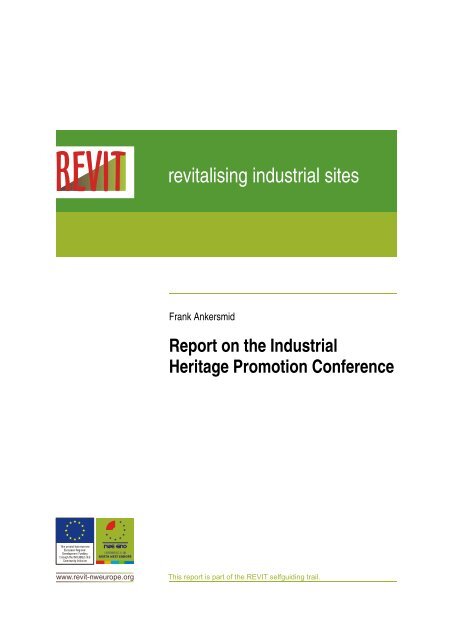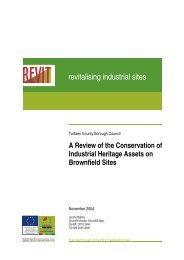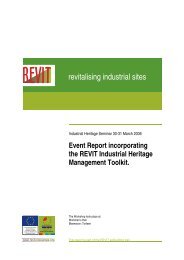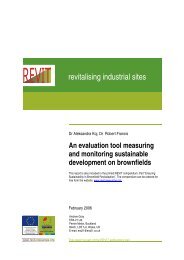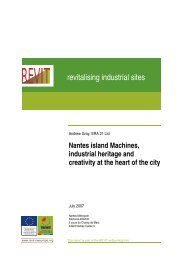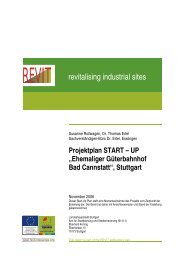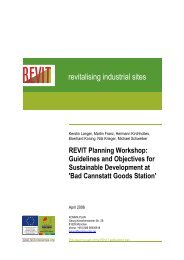Industial Heritage Promotion Conference.pdf - REVIT
Industial Heritage Promotion Conference.pdf - REVIT
Industial Heritage Promotion Conference.pdf - REVIT
You also want an ePaper? Increase the reach of your titles
YUMPU automatically turns print PDFs into web optimized ePapers that Google loves.
<strong>REVIT</strong><br />
revitalising industrial sites<br />
Frank Ankersmid<br />
Report on the Industrial<br />
<strong>Heritage</strong> <strong>Promotion</strong> <strong>Conference</strong><br />
www.revit-nweurope.org<br />
This report is part of the <strong>REVIT</strong> selfguiding trail.
Report on the Industrial <strong>Heritage</strong> <strong>Promotion</strong> <strong>Conference</strong><br />
Hengelo<br />
18 & 19 May 2006
The preliminary program was set up by Gerard Jilleba and Michael Haase and was approved<br />
in the Steering group of 6 December 2006. In this meeting an amateur photo-competition in<br />
all partner cities was added to the program, with an exhibition during the Hengelo<br />
<strong>Conference</strong>.<br />
After the preliminary program was approved, a first announcement was produced, which was<br />
widely spread during the Marketing Event in Nantes, in the Region of Hengelo and in<br />
partners cities.<br />
The preliminary program was worked out by Michael Haase and Frank Ankersmid into the<br />
definite program (see annex 1, the Invitation to the Industrial <strong>Heritage</strong> Event including the<br />
definite program). 1500 invitations have been sent to all different adresses in the Netherlands<br />
and all partner countries. The focus for this event was on brokers, house construction<br />
corporations and Industrial <strong>Heritage</strong> related associations, next to our Revit partner cities.<br />
In total about 80 persons attended the meeting (see annex 2, list of participants).<br />
Plenary session<br />
Presentations on a number of subjects were given. The first one was Mr. Peter Nijhof<br />
(Rijksdienst Monumentenzorg), about Industrial <strong>Heritage</strong> in the Netherlands. The second<br />
speaker was Mr. Dirk Baalman (het Oversticht), who talked about Industrial <strong>Heritage</strong> in the<br />
region, and after that Mr. Evert Jan Krouwel (Hart van Zuid, Supervising team) showed<br />
everyone the Industrial <strong>Heritage</strong> in Hart van Zuid. After a small coffeebreak Evert Verhagen<br />
(Creative Cities) started with a best practice example in the Netherlands: The<br />
Westergasfabriek in Amsterdam. Mr Edward Sargent held a presentation about the Industrial<br />
<strong>Heritage</strong> in the UK, and showed a best practise case “Chatham Dockyards”. Andrew Gray<br />
(Torfaen County Borough) presented the results of an expert meeting about Industrial<br />
<strong>Heritage</strong>, which was held in Torfaen at the end of March. Thomas Zuegler closed this<br />
session with a presentation on the venue for the Final <strong>Conference</strong> in Stuttgart on the 25th -<br />
27th of April 2007. All presentations are included on the CD.<br />
Workshop 1 Economical aspects (project management / finance / public-private partnership /<br />
risk allocation)<br />
A presentation by Jan Nieuwenhuizen and Fons Kurvers about the Public Private Partnership<br />
between the municipality of Hengelo and Van Wijnen N.V. was followed by a vivid discussion<br />
about the sharing of risks and benefits. In general, Fons and Jan found that the basis for a<br />
good PPP are faith in each other, clear goals and participation from both parties from the<br />
start. In the discussion that followed made clear that there has to be a clear understanding<br />
about sharing the risks and the profits.<br />
Workshop 2 Temporary destinations and cultural functions<br />
This workshop was held in ’t Heim (a technique museum) . After a presentation from Peter<br />
Nijhof about the importance and use of temporary and cultural functions in Industrial<br />
<strong>Heritage</strong>, including good and bad examples and discussion, a guided tour through the<br />
museum was given by Toon de Boer. Attendants of this workshop had the opportunity to see<br />
the museum and do things with old machinery. The building ‘t Heim itself is part of the<br />
Industrial <strong>Heritage</strong> of Hengelo, it’s the former factory school of Stork.<br />
Workshop 3 Design (public space, architecture)<br />
In this workshop a presentation was given by Harrie Abels (Architect ROC) and Radbout<br />
Seckel (Architect Fire station). They explained the idea behind the design, and what to take<br />
in to consideration when an old building is combined with a new design. After the<br />
presentations the group was taken to, and into, the buildings where they were led around by<br />
the two architects.
Exhibition ‘Factories’<br />
The workshops were followed by the opening of the photo-exhibition “Factories”, an<br />
exhibition of ten photos about Industrial <strong>Heritage</strong> with a size of 4 X 6 meters, displayed in a<br />
former factory Hall.<br />
The festive opening of this exhibition was part of the Industrial <strong>Heritage</strong> <strong>Conference</strong>. More<br />
information about this exhibition can be found on www.factories.nl. In the same hall, 10<br />
photos of Industrial <strong>Heritage</strong> of each Revit partner were displayed. Torfaen held a<br />
photographic competition for amateurs for their own workshop, and brought the 10 best<br />
pictures with them to Hengelo. Hengelo gave the order to a amateur photographic class from<br />
CREA. The rest of the partners used already existing photo’s of their Industrial <strong>Heritage</strong>.<br />
After the exhibitions, a guided walk through the Hart van Zuid area was on the program,<br />
showing all special sites in Hart van Zuid, like the former Foundry Hall, the “Weverij”,<br />
Tuindorp, and a.o. the Fire station. They also took a look in the “Gieterij” where the<br />
“zuidertoneel” was practising for their performance on stage.<br />
In the evening a dinner for all conference attendees was held in the “Houtmaat” a venue in a<br />
beautiful green environment near the citycenter of Hengelo.<br />
Forum<br />
On the second day a panel discussion was organised, led by Mr. Gerard Jilleba and<br />
facilitated by Mr. Henk Nijhof. Panel members were mr. Peter Nijhof, Mr. Edward Sargent,<br />
Mr. Evert Jan Krouwel, Mr. Evert verhagen and Mr. Andrew Gray. A full transcript of this<br />
panel discussion is available.<br />
Most important conclusions of the panel discussions are:<br />
• 1 The private partners have to be involved with the project in the earliest stage. This<br />
has the advantage that knowledge is used at the right time at the right place. The<br />
private parties have knowledge about the market, the public party has knowledge<br />
about the procedures etc. If you want to keep Industrial <strong>Heritage</strong> as part of your<br />
culture and history, public and private partners need each other.<br />
• 2 There are no good guys and bad guys if it comes to preserving Industrial <strong>Heritage</strong>.<br />
Often the realestate brokers get the image of bad guys, and the governments are<br />
the good guys. This image is not true! There are just good and bad practises!<br />
• 3 In Britain, there are three parties for funding Industrial <strong>Heritage</strong>; public, private and<br />
the charitable trust (like the lottery funds). Still the government has to take lead in<br />
redevelopping Brownfields. The risk of doing nothing is too big, because realestate<br />
brokers choose to the easier to develop sites, and will leave the government with the<br />
lands that are very difficult or very expensive to redevelop, if there is no regulation about<br />
the entire redevelopment of all sites.<br />
• 4 Preservation of Industrial <strong>Heritage</strong> asks for creativity in all ways and for all parties<br />
involved.<br />
All workshops from day 1 were repeated again, to give all attendees the chance to visit at<br />
least two workshops on different topics, and to give people the chance to vist only one of the<br />
conference days.<br />
In the afternoon 17 persons made a visit to the “Roombeek” area in Enschede. This is the<br />
area where the SE-fireworks factory exploded in 2000, leaving a big disaster area. This area<br />
has now almost been redeveloped and rebuilt. A presentation and tour was given by a<br />
representative of the projectbureau “Roombeek”. After that a visit to the “Rijksmuseum” in<br />
Enschede was the end of this conference.


